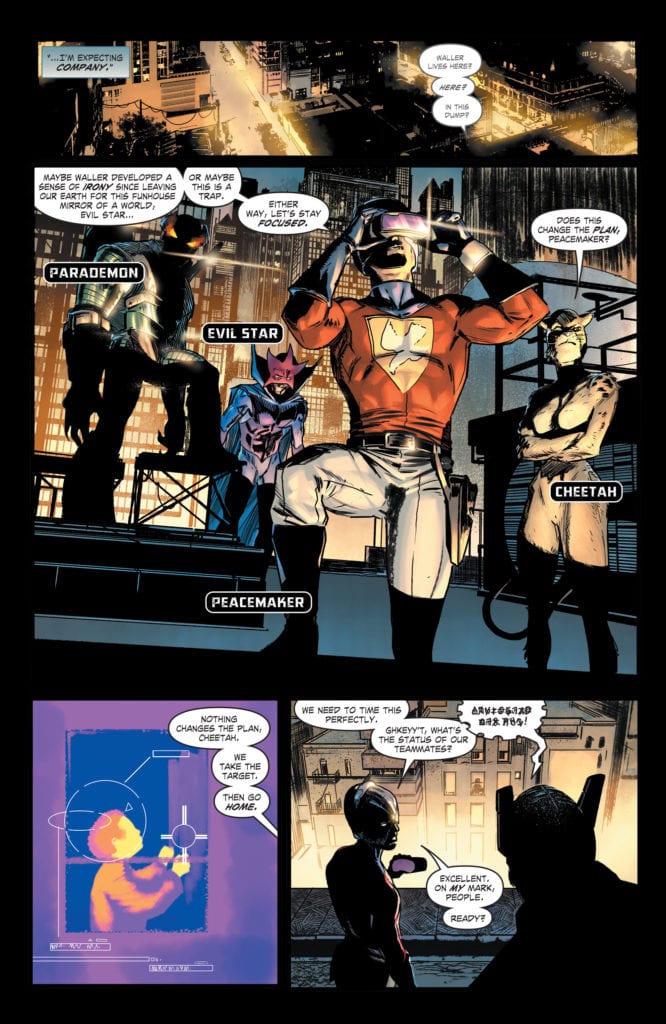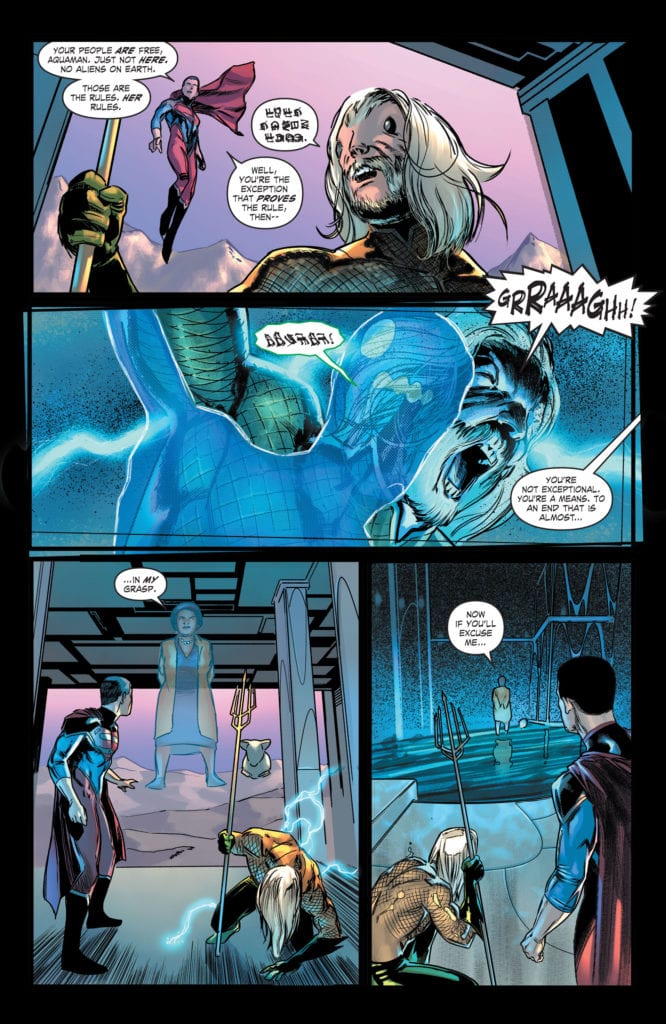DC Comics’ Future State: Suicide Squad #2 is a story about the end of worlds. In “Task Force: Next!” writer Robbie Thompson, artist Javier Fernandez, colorist Alex Sinclair and letterer Wes Abbott show where a Justice League led by Amanda Waller leads. And in Future State: Black Adam, writer Jeremy Adams, penciller Fernando Pasarin, inker Oclair Albert, colorist Jeromy Cox, and letterer Wes Abbott tell us that even DC’s most powerful heroes may not be able to stand up against the tide of Armageddon.
Future State: Suicide Squad
Writing
Thompson brings us to the finish line, sticking close to all of the strengths of our first chapter. Future State: Suicide Squad #2 isn’t any less mysterious. We’re left with just as many questions as we have answers. Part of the reason this issue is so mysterious, is because Thompson doesn’t hold our hand. When Peacemaker and Waller talk, there’s a history we’re not privy to. We’re watching two people who know each other deeply as they talk about things we can’t understand. It’s fantastic! It’s natural dialogue, free of exposition dumps and full of tension. If the quality of Future State: Suicide Squad #2 is any kind of sign of what to look forward to in Thompson’s Suicide Squad run, we’re in for a real treat.
Art
Fernandez takes us on a journey with his page layouts. We begin this story with a moment of peace. We see Superman watching over his teammates. His x-ray vision is depicted like word balloons. It’s ordered and tidy. But then, as Peacemaker’s team strikes, the page begins to fall part. Panels get jumbled and crooked. A scene of Mirror Master and the Flash fighting makes it hard to know which are mirrors and which are panels. It’s a fantastic infusion of chaos. But what is really interesting is Fernandez’s next page. More fighting, more death and destruction, shown in a page of right angles and ordered panels. It’s what defines the Suicide Squad. Little moments of extreme violence that don’t seem to phase the characters. The page layout is unsympathetic to the loss, just like our “protagonists.”

Coloring
A lot of Sinclair’s colors are slightly muted in this chapter. Our characters look like they haven’t been out in the sun in a while. Their skin is pale, their surroundings are often dull. Sinclair shows us a dark timeline. But there are a few tiny moments of color. Most often, these are moments of violence. The few moments of violence that actually effect our characters. One that stands out, due to Sinclair’s striking red used in the blood, is when a character doesn’t mean to have killed the person. We mirror their shock when we see the sudden use of brilliant color. But by the end of the story, everything looks like it’s turning grey. Sinclair shows us how these people have come to find casual violence dull. But it’s also draining them of life.
Lettering
Abbott brings a levity to this chapter that didn’t exist in the previous issue. Everything was quite final in Future State: Suicide Squad #1. Characters spoke their mind in short chunks. There was very little rhythm to what they said. Abbott showed in that chapter that these characters were just coasting. They said what they had to say and got right to the point. In this issue, however, everyone seems to be getting a little sing-songy. Most of the dialogue is parsed out into tiered word balloons. Rarely do we see characters say everything they have to in one go. Again, this shows us the casual reaction these characters have to violence. They’re almost laid back about killing each other. This is the reality they know. It’s the reality they’re comfortable in. Abbott really helps us see just how cheap life is to them.

Future State: Black Adam
Writing
Nothing about Adams’ writing should work. The whole script is riddled with exposition dumps. Gold Beetle enters, a Deux Ex Machina with all the answers in the world, and Adams gives us a text-heavy run through of what we need to know. It breaks just about every rule of writing. But somehow it still works. Maybe it’s Adams’ self awareness in this chapter. The previous issue suffered from taking itself a little too seriously at times. But in this issue, Gold Beetle is a breath of fresh air. Sure, she has answers, but she’s more interested in talking about her many exploits. And the twisty, strange and confusing journey that Adams takes us on does require a fair bit of explaining. This script might break a lot of rules, but it more than makes up for it by being boatloads of fun.
Art
Pasarin and Albert had their work cut out for them in this issue! Every page looks like something out of Where’s Waldo? They don’t skimp on any details. And, as a result, the story maintains its feeling of epic poetry. These don’t look like scenes from a comic book. They look like scenes from some grand mythology. It’s fitting, though. These are the death throws of the universe. And all of these moments of extreme drama are juxtaposed with Gold Beetle’s hilarity. Even her moments of real panic, coupled with her dialogue, lighten the mood. She brings the perfect balance to what could have been a melodramatic ending.
Coloring
There’s a heavy emphasis on blue and gold in this issue. It comes to signify which characters are our protagonists. Gold Beetle is a mash up of the two colors and Black Adam has a gold trim along his cape and a blue hue to the lightning bolt on his chest. These colors tend to be the only things that stick out when the Unkindness arrives. The sea of purple and red engulfs everything else. It’s the blue and gold that still stands out, a sign of our protagonists’ resiliency. But it’s also interesting, as we begin to associate Black Adam’s powers with blue, to see how close the blues and purples are to one another. We get the sense that Black Adam could be on the side of the Unkindness. He has that type of power. And as the issue ends, we’re left wondering if someday he really could break bad.
Lettering
Future State: Black Adam is actually a great companion piece to Suicide Squad. And not just because of its shared themes and tones. Abbott’s work in one really highlights his work in the other. Where Suicide Squad is nonchalant and rhythmic, Black Adam is earnest and dramatic. Gold Beetle’s lines don’t get the tiered-word-balloon treatment. They’re breathless chunks. She’s getting all the bragging in that she can before she’s interrupted. And the other characters seem like they can’t get a word in edgewise. They have tiny interruptions in word balloons with long tails. Abbott’s underlining the effort it takes them to be heard. It’s a funny, brilliant way of showing just how talkative Gold Beetle is.
DC Comics’ Future State: Suicide Squad was mysterious and explosive. Future State: Black Adam was an epic that delivered on its promises. Both of these stories were fantastic examples of why Future State was ripe with potential. These creative teams took that potential and showed just how far it could stretch. Pick up Future State: Suicide Squad #2, out from DC Comics February 23rd, at a comic shop near you!

